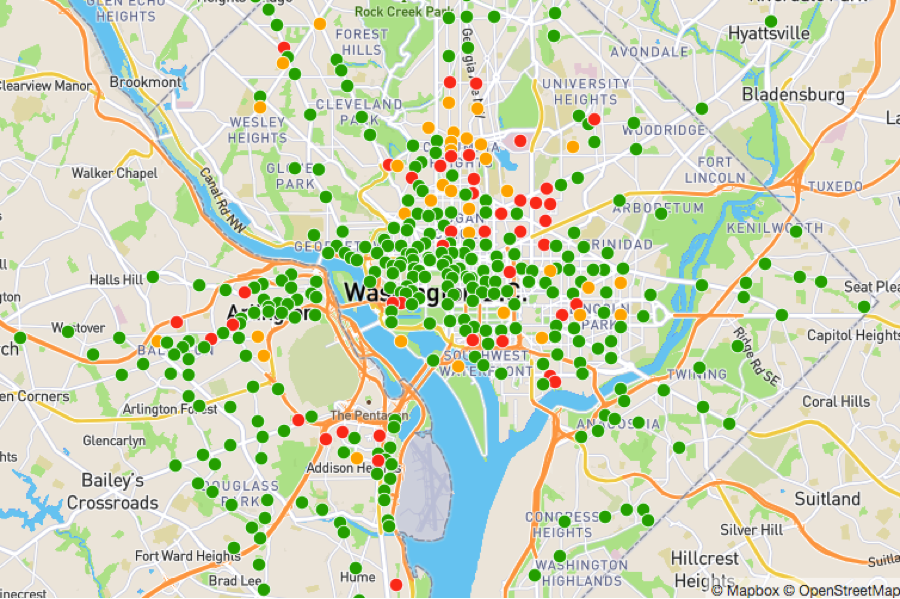June 14, 2018
Dockless bike systems, launched in the U.S. in 2017, have spread to dozens of cities. In addition to providing a transportation service with no government subsidy, they are addressing some of the limitations of traditional docked bikeshare systems and are attracting a more diverse group of riders. Dockless systems have lower costs, expand access to neighborhoods that don’t have docked systems, and tackle some of the challenges of personal bike ownership in low-income communities, such as riders’ barriers to addressing bike maintenance needs.
Despite improving access to citizens who have limited transportation options or cite other barriers to bicycling, most dockless systems still face challenges with respect to equity: they require smartphones and credit or debit cards in order to create an account, they require private citizens to pay for the service regardless of income, and they must operate in areas where they can make a financial profit. Dockless companies have begun to create innovative approaches to overcoming these challenges.
Allowing access for Americans that do not have smart phones or credit cards
A recent fact sheet from the Pew Research Center indicates that while 92 percent of Americans earning less than $30,000 a year own a cellphone of some kind, the share of those in this income bracket owning a smartphone drops to 67 percent. Further, according to a 2015 Federal Deposit Insurance Corporation survey, seven percent of U.S. households are unbanked, meaning they do not have checking or savings accounts and tend to rely more on cash than on cards.
Dockless mobility providers Lime and Spin have piloted programs enabling riders who don’t own smart phones or bank accounts to access dockless services. Last week, Lime announced a new partnership with PayNearMe, a service designed to allow customers to pay cash for bills and online purchases at participating retail locations around the country. To use the service, low-income Lime customers who qualify through a needs-based program can load 100 rides to their Lime accounts for just $5 in cash by visiting a local CVS, 7-Eleven, Family Dollar, or Casey’s General Store. Ordinarily, it costs riders $1 per 30 minutes to rent a LimeBike.
Spin’s pilot program in Seattle required text-enabled phones, so the challenge for dockless service providers will be to ensure that their services are accessible to those who do not have reliable access to personal phones. Services like PayNearMe present one potential solution to ensuring access among those who do not own personal phones, and could be expanded to docked bikeshare systems and other tech-enabled transportation.
Providing simple eligibility rules for financial assistance to low-income and unbanked riders
Capital Bikeshare has a confusing system of financial assistance programs available to low-income riders, who must navigate a complex process in order to qualify for lower cost membership and rides. By contrast, to qualify for access to Lime bikes, low-income riders must simply demonstrate qualification or participation in any state- or federally-run assistance program. This allows for low-income riders to gain inexpensive access to the system and reduces the administrative burden for the company and riders.
In addition, dockless mobility providers can work with cities to expand outreach efforts to riders that are eligible for financial assistance. Spin, Lime, and JUMP have all experimented with varying models of reduced-fare programs, providing an array of possible approaches to other dockless providers. Still, potential riders may not be aware of financial assistance programs for dockless bikes, or to the extent that they are aware, may not know whether they are eligible to participate. For dockless companies that choose to link discount eligibility to a city’s existing transit reduced-fare program, as with Spin’s connection to the ORCA LIFT card in Seattle, there should be clear indication to transit and bicycle riders of their expanded financial assistance options.
Expanding to areas where there are no bikeshare services.
Private companies deploying their dockless systems have an obligation to work with cities to ensure that they are improving communities. In a number of cities, dockless bikes are expanding access to neighborhoods where there are fewer traditional docked bike stations, as shown in the scarcity of docked bikes east of the Anacostia River in Washington, below.

Capital Bikeshare Station Map. Few stations can be found east of the Anacostia River
Dockless bike share systems can also be deployed outside of urban areas. Recently, Lime launched service in a Native American Territory through a partnership between the cities of Reno and Sparks, the Reno-Sparks Indian Colony, the University of Nevada, Reno and Washoe Counties, and the Regional Transportation Commission of Washoe County. Cities that have never had a bikeshare system, like Dallas, now have a dockless option for their citizens.
Regardless of whether the venture capital-backed private dockless companies remain financially viable in the long term, their experiments in expanding access and promoting equity could have lasting effects on the transportation system. The innovations devised by dockless companies can inform efforts to expand access to all transportation modes.




